Jump to section
How to Create an Effective Branded PPC Campaign
Brand Protection Crash Course
Lesson 1: Why is PPC brand protection important?
Unless you are entirely new to PPC, getting the significant gains we once saw is tough. PPC has matured as a marketing tactic for years, and few “easy wins” remain. Many categories are dominated by prominent players (e.g., Amazon), long-tail keywords have become expensive, and the most advanced marketers have complex technology and costly agencies.
Especially with first-page CPC bids on the rise, it can be tempting for advertisers to look for any opportunity to reduce costs, and sometimes branded campaigns get the ax.
But this is the wrong move.
We review massive amounts of data for branded searches. We’ve verified that competition for branded keywords is on the rise. If brands and their agencies do nothing, the result is higher CPCs, lower average rankings, and even advertisers and partners unknowingly working against each other.
Running an effective brand-bidding strategy focused on revenue growth and protection can drive leads effectively while preventing competitors from encroaching on your territory.
Key observations we’ve made while sifting through brand-bidding data include the following:
- Consumers love branded searches. The volume of branded searches is quite impressive. Using the Google Ads Keyword Planner, for example, we saw that in December 2020 alone, there were over 8 million US searches for “the north face” and 606,000 US searches for “north face jackets.”
- Brand bidding protects a majority of brand search traffic. Advertisers receive a large portion of their traffic from branded searches. One of our clients, a well-known travel brand, shared that they could capture two-thirds of the paid search clicks generated by those branded keywords. If this client did not support its brand, it would give up 66% of the clicks on its brand terms to competitors.
- Clicks decrease rapidly with more competition. Our data shows that brand owners can lose 50% of their click potential as competition increases.
- CPCs increase significantly with more competition. We also see that CPCs can jump more than 60% when competitors vie for the top three spots.
- Affiliate competitors distort metrics. Affiliates can reduce bid automation and conversion metrics by 20% or more.
With the volume of brand bidding on the rise, it requires considerable effort and focus to combat it, yet branded PPC campaigns can produce immense revenue. Some of our larger clients have told us that their strategies for protecting branded searches have earned them (or prevented the loss of) hundreds of millions of dollars of revenue annually.
But many advertisers find themselves at an impasse, as they recognize that branded campaigns have significant potential; however, they don’t know how to take advantage of it. We’ve written this course: to deliver a soup-to-nuts guide on developing an optimized branded search PPC campaign.
First, some foundational information:
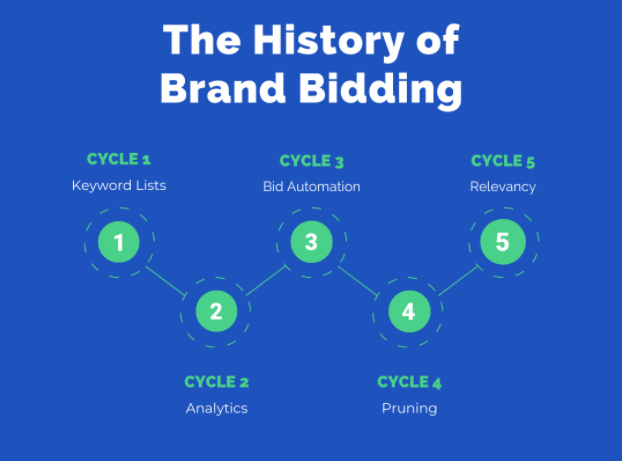
What’s the history of brand bidding?
The history of PPC is a short but intense journey. Looking back, we have noticed five distinct cycles in PPC optimization, each with increasing difficulty. New PPC users recreate this journey as they progress in sophistication. As you read through these five development cycles below, ask yourself where you think you are and where you’d like to be.
Cycle 1: Keyword Lists
This initial optimization tactic focused on the breadth of your keyword list. It was relatively easy because everything was new. Keywords were cheap! When pay-per-click was introduced, decent-volume keywords went for five cents or less. Even five years later, a search marketer who bid more than a few dollars on a click would be laughed at.
With low bid prices, search marketers were happy to experiment with the new channel. It was a learning environment, and competition remained low for years. Gains in revenue were tremendous as a result.
Cycle 2: Analytics
After building an exhaustive keyword list, marketers focused on their performance analytics for PPC optimization. They studied CTRs, conversion rates, CPCs, and anything else they could monitor, then tweaked their strategies subtly. The addition of advanced analytics enabled PPC gains to remain considerable.
Cycle 3: Bid Automation
After analytics, technological advances made it easier to automate many of the vast data chores associated with optimization. In particular, the automation of bids lets advertisers change their real-time costs to reflect changes in product costs or consumer demand.
Bid automation systems could control millions of PPC bids, and the quality of data inputs (analytics) became even more vital to PPC optimization. This new technology helped usher in the next cycle of PPC optimization.
Cycle 4: Pruning
After gains from analytics and automation were exhausted, the seasoned marketer took an even closer look at their campaigns for available refinements in performance. Engines were constantly rolling out new optimization features for advertisers, and the popular ones were a negative match, search queries, and other cost analysis tools. They used these to prune out the significant cost drivers that didn’t deliver the performance. Another massive leap of gains happened in cost optimization.
Cycle 5: Relevancy
The most recent cycle in PPC optimization occurred when marketers optimized their campaigns against the new arena of Quality Scores and search engine mandates for relevance. Search engines value greater relevancy at all costs and have rewarded those marketers that complied with cheaper CPCs.
Brand Bidding As The Next Cycle
Fast forward to the present day, and marketers are looking for the newest tool or technique to generate significant gains from PPC performance. The Search Monitor believes brand bidding is the next cycle in PPC optimization.
Brand Protection Crash Course
Lesson 2: The value of brand keywords
What are brand and brand-plus keywords?
A brand keyword is used to search for a company name. A recognizable example is “Macy’s.” Brand keywords such as “Macy’s” can include apparent misspellings.
A brand-plus keyword, meanwhile, refers to a keyword phrase that includes the brand term plus a qualifying phrase. An example would be “Adidas running shoe.” There are many variations, such as:
- Brand + product name: “Adidas Flux”
- Brand + review: “Adidas Ultra Boost review”
- Brand + coupon: “Adidas coupon.”
- Brand + sale: “Adidas sale” or “Adidas discount”
- Brand long tail: “Adidas men’s Springblade running shoe size 13”
- Brand + website: “www Adidas” or “Adidas website.”
Brand keywords represent an immense amount of search traffic, while organic traffic makes up the minority.
A 2020 study by Bing on automotive ads found that advertisers earned 2.1x more total clicks when they served a paid ad for their brand versus relying on organic search listings alone. Why?
When a shopper searched for an OEM brand whose ad was missing from the search results page, their organic pages missed 59% of clicks. That meant that the brand captured just 41% of clicks when relying on organic search listings alone, while competitors captured 29% of those clicks on their brand name (21% of which came from paid ads).
However, when they served paid ads on brand searches, OEMs captured 86% of total clicks (78% from paid ads and another 8% from organic listings). More critically, branded ads significantly reduced the amount of traffic captured by competitors, from 29% to 8% of total clicks for OEM brand terms. (Source: Microsoft internal data, May – July 2020, U.S. Bing only)
Something to remember: some consumers use search engines as a replacement for the browser address bar. A typical behavior is to type the website address into the Google search box. Brand bidding allows you to capture these clicks and their high click-through rates.
Branded search campaigns allow brands to deliver a more compelling experience that drives higher conversion rates.
When a customer clicks through to your landing page from a branded search, you have more control over their experience with your brand. With organic searches, you do not have control over where they land—Google makes this determination. With paid ads, you decide where users go.
With a dedicated landing page experience and more control, you can more easily convert paid traffic to your branded search terms. Running an ad on your branded keywords lets you control the landing page experience much quicker than you can with your organic listings. Optimized landing pages, especially with continuous A/B testing, convert at higher rates than non-relevant landing pages.
In addition, studies have shown that branded keyword phrases are 5x more likely to convert visitors into leads, and paid conversion rates can be upwards of 4x higher than organic conversion rates. Conversions should have a paid ad representing you rather than relying on your organic listing.
Every branded campaign starts by assembling a list of keywords incorporating your brand name.
With the ‘why’ out of the way, it’s time to discuss the best practices for implementing brand bidding campaigns. As with any PPC campaign, brand bidding begins with effective keyword development. There are plenty of primers on keyword selection and keyword research tools on the web if you need to review the basics. These apply to brand campaigns, too.
To start, you can find the relevant brand and brand-plus keywords by reviewing your existing campaigns and analytics for generic terms that drive the best traffic, then add your brand terms in front of them. For example:
- Brand + product name: “Burton snowboard”
- Brand + review: “Burton Snowboard review”
- Brand + discount: “Burton discount.”
- Brand + sale: “Burton sale.”
- Brand long tail: “used Burton Process Flying V Snowboard 2016 157W”
- Brand + website: “www.Burton,” “Burton.com” or “Burton website”
You can also check Google’s autocomplete suggestions in the search bar and the list of related searches at the bottom of the results page for other common searches using your brand.
Your ad copy should incorporate the keywords you’ve assembled to ensure the best possible ad scores. But what do you do if a competitor uses your brand in their ads?
It’s essential to keep a close eye on your competitors’ ads and be ready to fight back if they use your brand terms.
Competitors using your brand terms are there to steal your clicks and piggyback on your good name. Competitors can cause you to lose clicks and increase the cost-per-click of your brand terms. Worst yet, they can overtake you in rank, pushing you down the page.
Your number one goal is to remove as many competitors as you can. The search engines will help you with this exercise. Start by familiarizing yourself with the engines’ trademark policies.
Then, be vigilant in monitoring your brand terms. If you find a competitor using your name in their ad copy title or text, be relentless in reporting them to the search engine in question (more on this later). Remember that search engines typically allow ads to use a competitor’s brand name in an ad’s display URL.
Search engines have compliance departments set up to review trademark infringement complaints. If an ad infringes on their policies, they will take it down immediately. If the ad does not violate, the search engine will allow the ad to continue to run. If the latter happens, don’t take it personally.
Don’t worry about getting penalized for reporting competitors’ ads. Search engines recognize the necessity of businesses taking steps to protect their brands and so expect such complaints. However, you may find yourself having to initiate many such complaints. If you can automate the reporting process, you should.
If your take-down attempts fail, it is most likely because the competitor is not using your brand name in its ad copy. (Or a competitor may adjust their ad copy, removing the term from the copy but still running ads against your branded keywords.) By not using your name, the competitor’s ads are likely not very relevant to the search term, which will cause their quality score to decline and their CPC to increase. Their costs will balloon as a result, which is what you want since it allows you to outbid them more easily. You may be able to outrank them despite having lower bids if your ad scores are significantly higher.
Remember, they may ignore their plunging return-on-ad-spend (ROAS) and continue bidding on your brand terms. It can be frustrating, but let them spend the money. Advertising budgets are finite. If they’re exhausting their budget on poorly optimized campaigns targeting your brand, that’s less money they spend elsewhere.
You can also cause them additional pain by cranking up the heat with partner arrangements.
Brand Protection Crash Course
Lesson 3: Brand bidding best practices & techniques
You should follow a few rules of thumb with your brand campaigns to ensure the best possible performance.
In addition to the standard best practices for ad copy and landing pages, like title-matching your keyword, here are other best practices for brand bidding:
- Official Site. Consider using “official site” in your ad copy. An ad title like “Burton Official Site” can draw clicks away from wanna-be competitors and significantly increase your CTR.
- Landing Pages. Ensure your landing page’s contents match your would-be customers’ expectations. Nobody likes clicking on an ad for blankets and getting a page for shoes, or even worse, seeing the dreaded 404 error page.
- Ad Extensions. Be sure to use ad extensions, specifically site links. Site links will make your ad BIGGER! Big ads take up more room, which pushes competitors down on the page. You can also add business phone numbers, third-party reviews (if you sell products) and display a local address if you have retail locations. We also encourage you to use call-out extensions to add offers, brand slogans, or “official reseller” status.
- Offers. In a recent analysis of offers run in skin care ads, we found that 34% of ads mentioned free shipping, 29% noted a sale, 22% included claims, and 13% offered free products. Highlighting offers like these can make your ad more enticing and increase clicks.
You might not need an offer if you have a strong brand and show value in your ad copy. However, before you decide, you should evaluate the competitive landscape.
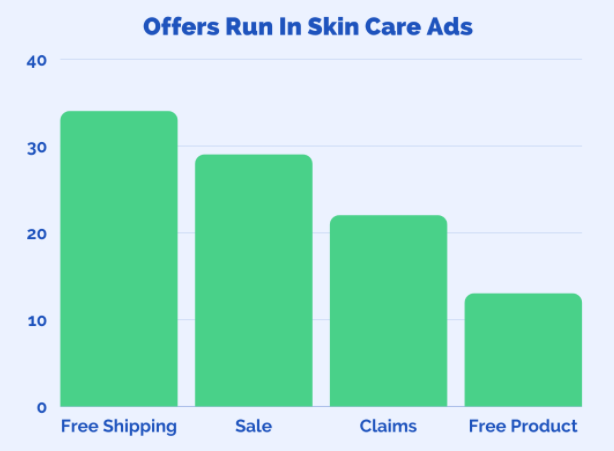
You don’t want your competitors bidding on your brand terms—but you may wish to bid on your competitors’ terms.
Yes, we’re hypocrites. We talked about how to stop competitors from bidding on your terms. This practice is known as “piggy-backing.”
Who can benefit from piggybacking? Just about everyone. Small, lesser-known brands can use piggybacking to ride the coattails of a more significant competitor and gain exposure. On the other hand, if you are a big brand with a better product than your competitor, you can use this tactic to tell the marketplace what makes your product superior.
To piggy-back effectively, you will need to follow these rules:
- Ad Copy. Do not use the brand in the title or description of your ad, or you will get your ad taken down.
- Comparisons. Ensure that your ad focuses on comparing yourself to the competitor’s product or brand in a legal, non-derogatory way.
- Display URL. Use their brand in your display URL to make your ad relevant and protect your Quality Score (e.g., mydomain.com/yourbrand-vs-theirbrand).
- Landing Page. Ensure the landing page targets the comparison you espouse in your ad. It must thoughtfully and accurately compare your features and benefits. Find a third party who has done the comparison for you.
Brand Protection Crash Course
Lesson 4: Partner & Affiliate Relationships
You can cut costs and drive leads by carefully coordinating with affiliates and other partners on brand bidding.
First of all, identify your potential partners:
- Affiliates are partners who send visitors to the brand holder’s website through a referral link. Online retailers commonly work with partners through affiliate networks such as Rakuten or Commission Junction. Examples include coupon code websites.
- “Resellers” is a fancy term for affiliates who refer leads instead of direct purchases. The reseller captures leads and sends them to the brand holder for conversion. We often see resellers operating in finance, insurance, and telecom. An interesting nuance to this type of relationship is that the reseller usually has the authorization to use the brand in its URL, for example: “www.verizonfiosbundles.com” or “www.buyverizon.com.”
- Partners. Travel services (such as hotels) work through online travel agencies like Priceline or Expedia.
- Franchisees or Dealers. A franchisee (or dealer) relationship is a brick-and-mortar concept commonly found in automotive or education, where there is a physical, in-market store. The dealer has certain marketing rights restricted to a geographic boundary in these arrangements.
- Online Retailers. We don’t usually think of retailers as “partners” or “affiliates,” but they are if the brand holder is a manufacturer. Manufacturers sell through retailers and can benefit from the page ownership strategies discussed here.
Working collaboratively with your partners can help you dominate the first page of search results, drive more revenue, manage costs, and build your brand. By carefully selecting a group of your best affiliates and other partners to work closely alongside you, you can use this powerful cost-cutting technique to boost clicks and sales.
Here are some tactics that will help you better control search engine results and your CPC prices by coordinating your brand bidding with partners and affiliates:
- Identify a group of affiliates you will allow to bid on your brand.
- In your contracts, spell that no affiliate can rank above you in branded PPC.
- Ensure affiliates have more relevant ad copy than your competitors by helping them to describe your products and services in depth in their ads and landing pages.
- As you refine the program, consider whether you should remove brand-bidding rights from all but your best three affiliates. This helps make sure your CPCs don’t get out of control.
Affiliate management and coordination take constant vigilance (PPC has no freebies!). This is accomplished with dedicated personnel and PPC monitoring tools that can automate the detection, reporting, and communication with affiliates and the engines.
Whatever industry you advertise in, the coordination of brand bidding with the partners described above has tangible and measurable benefits, including:
- Controlling the first page of results
- Pushing out competitors
- Lowering CPC costs
- Driving more visits
- Improving ROAS
- Growing revenue
Implementing a cohesive partner brand bidding strategy with trusted partners is critical to dominating the competition.
Partner brand bidding means allowing some of your partners to bid on your brand name or brand-plus phrases—as discussed above—to control the page of real estate. For partner bidding to work, you need to run a tight ship. Your tactics must include four key elements:
Tactic #1: Media Strategy
Before implementing a partner strategy, you must define your media strategy. This, in turn, will help you formulate your program rules. Questions to address include:
Would you like to brand bid alongside partners? You will bid heavily on all brand variations if you have an active and aggressive SEM strategy. You will want your partners at your side, with you in the first position and your partners blocking the ranks directly below you from competitors. Some companies have hundreds of affiliates but may only allow PPC brand bidding for their best three or four partners (super-affiliates).
Would you like to use partners to offset PPC ad spending? If you want to scale back your ad spend on PPC (maybe you had a budget cut), you can use your partners to fill in the gaps. In this case, you can anoint a few special super-affiliates and encourage them through incentives to maintain the top ranks. Or you could adopt a very loose brand-plus bidding policy and allow all of your affiliates access. If you’re in this boat, please remember you still need to bid on your name. Do not give that up!
What about offering incentives like co-op ad money? As a manufacturer, you could control the search results pages better by offering co-op ad dollars.
Tactic #2: Legal Agreement
Once you have defined your media strategy, it’s time to meet with your legal team and put the plan into writing. You will need a well-defined legal agreement that explicitly explains the rules of the engagement, notice procedures, and enforcement (i.e., you lose your payout or hasta la vista, baby, you’re kicked out of the program!).
The areas where restrictions can apply include:
- Allowed and prohibited keywords. Be specific and define classes of keywords.
- Allowed and prohibited ad copy. You can refer to an external policy document that occasionally changes to give you flexibility with wording and offers.
- Page rank. If bidding alongside partners, you will need to define page rank rules. Examples include: never above you, or your brand is always first on keywords x, y, and z.
Tactic #3: Ad Monitoring
With the strategy and legal out of the way, it’s important to remember that your plan to corner the market is only as good as your enforcement. Best practices here include:
Using ad monitoring software: search ads on each page refresh and vary based on the user’s location. It is nearly impossible (and boring) to monitor them manually. Please ensure you find a vendor who can check ads several times a day and across multiple locations. If you are hyper geo-sensitive, as you should be in industries such as telecom or automotive, your vendor must provide city and maybe even ZIP-code-level monitoring.
Review summaries, not the details: clients often ask us to send alerts for every violation we find. Before you request something similar, consider this: If we were to monitor 30 brand-plus terms across 100 geographic territories, that would equate to 3,000 checks at a time. Do you want 30, 300, or 3,000 alerts to review? Instead, we recommend you look at the summaries. If the percentage of territories with violations becomes considerable, it’s time to take action. One caveat for you: If you are in a regulated industry with ad copy sensitivity, every violation counts and needs to be considered.
Tactic #4: Compliance Enforcement
Your legal agreement should detail how you will enforce your policies. Remember to be kind to your super-affiliates with fair notices and consequences, and act swiftly against those that are not your super-affiliates, as they are just mucking up your plan, and this will help to demonstrate to super-affiliates that there are benefits to achieving and maintaining their status as such.
Implementing a partner brand bidding strategy requires time and effort, plus some common sense regarding enforcement. It’s important to remember that partners are taking on the cost and risk of promoting your product. They will most appreciate receiving clearly defined brand PPC bidding rules. Since search engine algorithms are (and will remain) black boxes whose costs are based on vague concepts such as relevancy and quality scores, it’s essential to control whatever you can.
Brand Protection Crash Course
Lesson 5: Reducing Competition
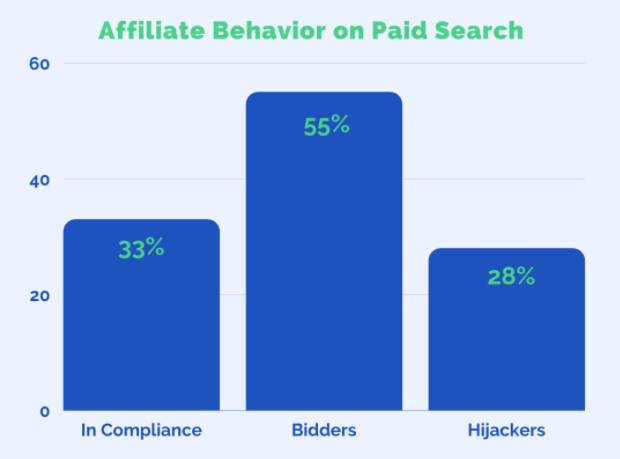
What are some effective strategies for minimizing competition when running branded PPC campaigns?
If you have a brand worth protecting, competitors are already bidding on your brand name. Some bid directly on your name, while others bid on obvious derivatives, such as when Marketo bids on phrases like “Pardot drip marketing” and vice versa. Many large brands have competitors bidding on every ad position for every imaginable brand and brand-plus keyword.
What can you do to deal with competitors brazenly appearing in searches for your name? Your best options include:
- Complain. If the competitor uses your name in the ad copy, file a complaint with the search engine. We address this in more detail below.
- Own more real estate. As described above, you can take over more of the page real estate by working with partners.
Be better than them. Being better means earning a top Quality Score, while the competitor needs to. This means that you pay a reasonable CPC while the competitors pay more! If the ROAS isn’t there, the competitor(s) will stop brand bidding because it’s not worth it. Further optimize your brand bidding efforts using remarketing, ad copy development, offer development, and landing page development.
Here are a few do’s and dont’s to help you optimize your brand bidding efforts, which in turn will reduce the impact of competition:
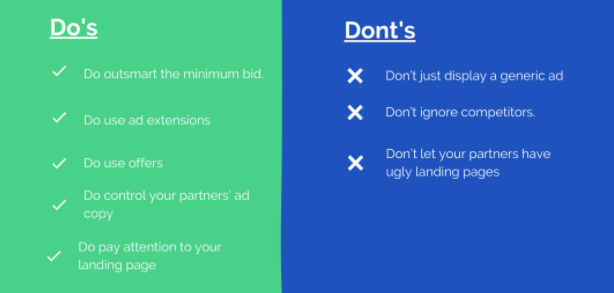
DO outsmart the minimum bid. Presuming you have optimized your ad copy and landing page — making you the most relevant brand bidder on your brand — then ask yourself, does the minimum bid apply to you? It might not. Try ignoring the first-page minimum bid and instead bid a bit lower to learn where you rank. If you have success, your partners should follow suit. Don’t think you have to outspend your attackers dramatically.
DON’T just display a generic ad. If the consumer found you through a brand-plus keyword, they likely want to buy something. So, promote that “something” in your ad copy.
DON’T ignore competitors. Some savvy competitors might be attacking you in their ad copy, focusing on your product quality or pricing (e.g., “They rip you off, and we won’t!”). Study your competitors’ talking points closely, and use your ad copy to address their attacks head-on. If they mention their lower prices, for example, be ready to emphasize your products’ other virtues. In addition, if you are a manufacturer, make sure that only authorized resellers are brand bidding (if they are allowed). If you find an unauthorized reseller, take the necessary steps to stop their brand bidding, either through complaints to the search engine or by directly asking the reseller to stop.
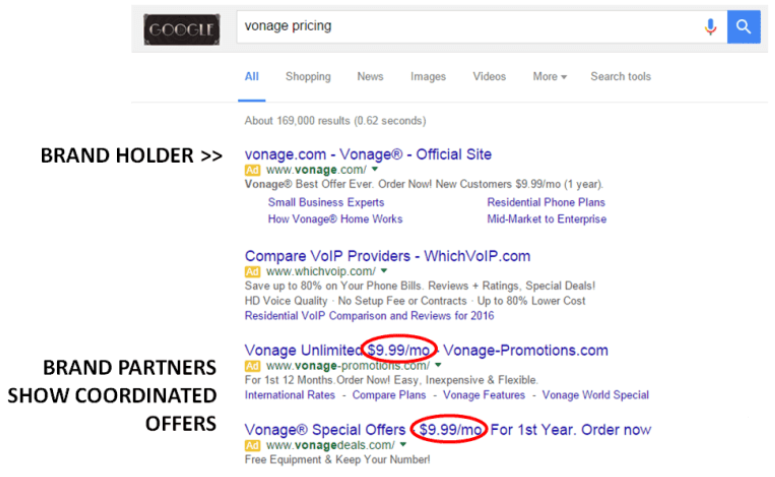
DO pay attention to your landing page: high-quality, relevant landing pages can differentiate you from competitors and lower costs.
DO ensure your landing page highlights the keyword, and if you have an offer in the ad copy, repeat it on the landing page. This is Landing Page 101!
Too often, we see inappropriate landing page selections, even with major brands. Recently, we searched for “Macy’s cotton blankets” and saw a Macy’s ad as the first result. When clicked, however, no cotton blankets appeared on the landing page — just a list of 64 blankets, unsorted and unfiltered, which was unlikely to drive interest and conversions.
DON’T let your partners have ugly landing pages. Your partner strategy will lose effectiveness if the landing page experience is poor. For example, we once found an ad promoting a holiday special with a Christmas motif in March!
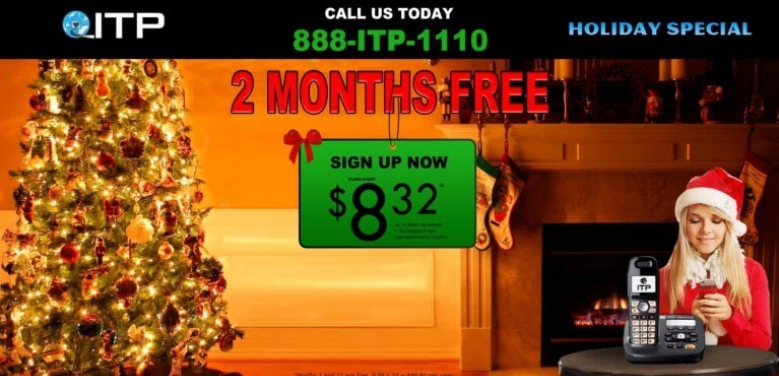
Brand Protection Crash Course
Lesson 6: Brand bidding enforcement options
What are your legal options if competitors refuse to stop abusing trademarked brand terms in their PPC campaigns?
What can you do about unwelcome competition from a legal standpoint once you detect unwelcome competition? We won’t bore you with case law here, but you should be aware of a few basic principles and how the law views brand bidding:
- Trademark registration. You must register your trademarks with the USPTO (United States Patent and Trademark Office) to maximize your enforcement rights regarding your brand name and slogans.
- Brand confusion protection. The primary purpose of a trademark is to identify your product uniquely. It prevents another business from promoting a product in a manner that is confusingly similar to your branded product. To win a brand bidding case, you must show that your competitor’s ad will likely confuse consumers. This single concept is tough to prove and is why brand enforcement using the law and courts is very difficult — more on that in a moment.
- Fair use. This term signifies that your registered marks can be used by advertisers such as resellers, news outlets, reviewers, or product comparisons in exceptional circumstances.
- The law and brand bidding. Brand owners have brought numerous lawsuits against ad sellers (Google and Bing) and ad buyers (competitors). The main finding has been that these lawsuits have gone virtually nowhere as a group. Unfortunately, we still don’t know where the law stands.
- Trademark owners RARELY win cases against ad buyers. Why? The burden of proof is too high. Trademark owners must show that their competitor confused a consumer with their ad. To do that, the court requires the competitor to blatantly rip off your product description and have a web address and landing page similar to yours. Otherwise, they believe that consumers are too smart to be fooled. If no one gets fooled, you lose these lawsuits.
- Trademark owners NEVER win cases against the engines/ad sellers. This painful reality exists because all cases have either been dismissed or settled out of court, so there have been no court judgments. Courts have never expressed a negative opinion about brand bidding and sometimes endorsed the practice.
To enforce compliance against competitors and affiliates, you have three options: 1) Search engine complaints; 2) pacts or agreements; and 3) lawsuits, explained below.
Search Engine Complaints
Filing a complaint with Google or Bing is recommended because it’s cheap (free to file) and easy, mainly if you use an ad monitoring platform to detect and file the complaints on your behalf automatically. Before you get too excited, however, there are some limitations:
- Protected items: Only registered trademarks are protected.
- Allowed items: Generally, each engine deals with trademark infringement as follows:
- Brand bidding: Allowed. Anyone can bid on your name, as shown when we discussed best practices, managing partners, and reducing competition.
- Ad copy use: Not allowed (with a few exceptions). However, fair use rules allow resellers, affiliates, reviewers, and news outlets to use your name in ad copy.
- Destination URL use: Allowed. Competitors can use your name as a sub-domain or sub-page. In the best practices section, we even suggested that you do this to your competitors. Note that while the engines allow this, it does not mean that the law allows it. The more confusingly similar a URL is to the brand holder’s, the stronger the brand holder’s case becomes from a legal standpoint.
Pacts & Agreements
Another method to enforce protection is with agreements. Agreements give you more robust and reliable legal recourse than just complaining to the engines alone.
Competitive pacts: some industries have gotten together, and competitors have formed written alliances where they have specifically agreed not to brand bid. These written agreements detail the allowed and prohibited activity, alongside enforcement proceedings, should they be violated, which typically come with a financial price tag.
Affiliate agreements: if you have affiliates or partners, your affiliate agreement should detail the allowed and disallowed brand bidding activity, along with notice rules and financial ramifications for any violations. The swiftness and harshness of your action should match the conduct, which includes:
- Direct linkers: this harmful advertising practice is when affiliate marketers assume the identity of the represented merchant in paid ads. It should be dealt with swiftly since someone is hijacking your brand outright. Actions should include financial withholding and termination of the relationship.
- Unauthorized affiliates: affiliates who brand bid without authorization are mucking up your strategies. Actions should include a notice with cure periods, financial ramifications, and eventual termination if the behavior is repetitive and material.
- Authorized affiliates: super-affiliates (as discussed in the reducing brand bidding competition topic) should be handled more gently, with kinder notices that build upon themselves and provide cure periods. Financial repercussions and termination should only be used as a last resort.
- Reseller agreements: If you are a manufacturer, you likely have strict rules regarding sensationalized copy, minimum advertised price (MAP) compliance, and brand bidding. Your contracts should detail these rules and the consequences of not following them.
Lawsuits
A lawsuit based on trademark infringement should be your last resort. Trademark lawsuits are expensive and challenging to win (as noted earlier). The caveat is that if you have a pact or agreement that prohibits brand bidding and proof of the advertising activity through date/time-stamped screenshots, you have a more substantial chance for victory.
The enforcement component of a successful brand bidding strategy is well within the reach of any marketer or agency. Enforcement is attainable with a foundation of always-on ad monitoring, coupled with complaints to the search engines (who do listen!), strong agreements to clarify what’s permissible within your industry and with partners, and (as a last resort) lawsuits.
If you’ve made it this far, you’ve gained enough knowledge to take the first steps toward protecting your brand while bidding effectively on others. But having practical tools is also critical to succeeding in the hyper-competitive world of PPC brand campaigns. Great work!
Share on Social
See Our Data at Work
Provide us with a competitor’s website, a set of keywords, or one of our 1,000+ verticals, and we’ll show you the power of our monitoring capabilities. Request a personalized demo today and see what our insights can do for you!
Trusted by







 Brand Protection
Brand Protection SEM Insights
SEM Insights Affiliate Compliance
Affiliate Compliance Ad Armor
Ad Armor Learning Center
Learning Center Guides & Webinars
Guides & Webinars We Love Data™
We Love Data™ About Us
About Us Our Data
Our Data Careers
Careers Our Team
Our Team News
News Contact Us
Contact Us